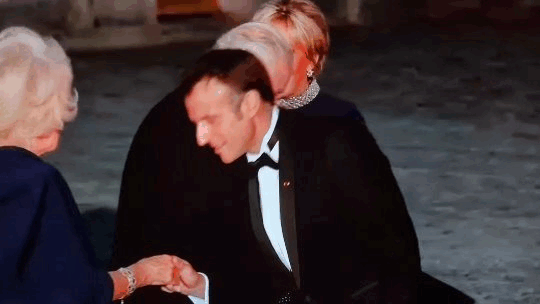#state visit to france
Explore tagged Tumblr posts
Text
Barbie! 🩷✨🌸


The Queen of the United Kingdom arrive at Orly Airport at the start of a three day state visit to France | September 20, 2023
#she totally slayed today#i love her in pink#pretty in pink#not the biggest fan of the hat#but a perfection nevertheless#state visit to france#queen camilla#camilla parker bowles#camilla shand#brf#king charles#king charles lll#brff
154 notes
·
View notes
Text

Been meaning to do this thing for a while
#countryhumans#countryhumans art#countryhumans america#countryhumans united states of america#countryhumans usa#countryhumans Iceland#countryhumans cambodia#countryhumans italy#why yes I changed Italy from a Guy. to a beautiful woman#countryhumans russia#countryhumans france#first french empire to be exact#based off that one napoleon painting#countryhumans madagascar#countryhumans vietnam#geldraws#geldoodles#I find it funny that i#who lives in a tropical country whose suffered through an AWFUL heatwave this year#wants to visit Iceland#a country that is cold as fuck
155 notes
·
View notes
Text


King Philippe of Belgium, Queen Mathilde of Belgium and Prince Gabriel of Belgium with French President Emmanuel Macron and First Lady Brigitte Macron as they attend a State dinner on the occasion of King Philippe of Belgium and Queen Mathilde of Belgium's State Visit in France, at the Presidential Elysée Palace in Paris, France -October 14th 2024.
📷 : Belgium Foreign Affairs, Foreign Trade and Development Cooperation / Vlad Vanderkelen.
#king philippe#queen mathilde#prince gabriel#prince gabriel of belgium#belgian royal family#belgium#2024#october 2024#emmanuel macron#brigitte macron#france#france 2024#paris#paris 2024#state visit belgium#state visit belgium 2024#royal children#my edit
19 notes
·
View notes
Text
Very funny how neither CS Forester nor Patrick O'Brian were buried in England. Guys really said yeah I'll write about it but I don't like it that much
#it makes sense for both of them they seemed to like their adopted countries better and pob seemed halfhearted about englishness anyway#but it is very funny that they spent a whole lot of their lives in the united states and france respectively#this re: discussion of the guys' graves and whether or not to visit#i'm going to go to cotlliure this summer though my parents refuse to believe me but i'll make it work#french can't stop me it's just badly pronounced catalan and i'll only speak to old people if i have to#perce rambles#percy yells at cecil scott#The Creative Endeavor and other aubreyad nonsense#going to go to sleep before my powers of speech get any further disjointed goodnight
43 notes
·
View notes
Text









President Emmanuel Macron and wife Brigitte Macron with King Charles III and Queen Camilla
11 notes
·
View notes
Text

(photo from The Court Jeweler)
She looks good as hell!!!
12 notes
·
View notes
Text
#Biden aims to deepen transatlantic ties with trip to France for D-Day#state visit amid Ukraine crisis
2 notes
·
View notes
Text
a banquet in this gorgeous hall and not a sartorial serve in sight 🤦♀️

#the swedes are my beloved but the way that no one served#the only highlight was the cameo tiara#king carl xvi gustaf#queen silvia#crown princess victoria#prince daniel#prince carl philip#princess sofia#sweden: france state visit
5 notes
·
View notes
Text
non citizens should be able to vote.
#this isn’t about immigrants#or even the us#if your visit to a country happens to overlap with their election you should be allowed to vote in it#greek election coming up but you’re in new zealand?#have a spare grand lying around?#go influence their future baybeeee#would this immediately be abused? yeah obviously#but think how fun it would be#think how different america would be if the rest of the world got to go Absolutely Fucking NOT every few years#think of the chaos in a country’s airports during their election week#come on. tell me this isn’t a great idea.#australia#election#new zealand#francs#america#united states#britain#election season#airports
1 note
·
View note
Text
King Charles toasts successful state visit to France with glasses of wine and a few whiskies | In Trend Today
King Charles toasts successful state visit to France with glasses of wine and a few whiskies Read Full Text or Full Article on MAG NEWS

View On WordPress
#Celebrities#King Charles toasts successful state visit to France with glasses of wine and a few whiskies#Money#Motors#Politics#ShowBiz#Sport#Tech#Trends#UK#US#World
0 notes
Text
King Charles toasts successful state visit to France with glasses of wine and a few whiskies | In Trend Today
King Charles toasts successful state visit to France with glasses of wine and a few whiskies Read Full Text or Full Article on MAG NEWS

View On WordPress
#Celebrities#King Charles toasts successful state visit to France with glasses of wine and a few whiskies#Money#Motors#Politics#ShowBiz#Sport#Tech#UK#US#World
0 notes
Text
She is an absolute cutiee-piee! 💚✨

The Queen of the United Kingdom depart the Elysee Presidential Palace after their meeting with French President Emmanuel Macron and his wife Brigitte Macron in Paris, France | September 21, 2023
#also i am obsessed with the pattern on the dress#i have skirt in exactly the same pattern#i stole it from my grandma haha#milla's fashion game has been strong on this state visit#she is amazing#queen camilla#camilla shand#camilla parker bowles#state visit to france#brf#brff
73 notes
·
View notes
Text
The U.S. seems only to understand pregnancy as a distinct and fragile state. For the expectant, we issue reams of proscriptions—more than can reasonably be followed. We tell them what to eat and what not to eat. We ask that they visit the doctor regularly and that they not do any strenuous activity. We give them our seats on the bus. Finally, once they’ve actually undergone the physical trauma of it, their bodies thoroughly depleted, we beckon them most immediately to rejoin the rest of us. One New York mother summed up her recent postpartum experience this way: “You’re not hemorrhaging? OK, peace, see you later.”
The Chinese traditionally adhere to 30 days of restful confinement—another week for a C-section—during which time moms are meant to consume lactation-inducing soups and herbal tonics and abstain from sex and cold water. In Mexico, the ritualized interlude, or the cuarentena, goes for 40 days, or long enough for the womb to return to its place. Balinese women are not allowed to enter the kitchen until the baby’s cord stump has fallen. Dutch maternity nurses make postpartum visits every day for the eight days after childbirth, and in France, as elsewhere, new moms spend nearly a week in hospital.
Always, the mothers are educated as they convalesce; they’re taught to breast-feed, to manage baby rashes and bath time and sore nipples. Rarely are they first to respond to the infant’s shrieking. In 2011 I visited a luxury postpartum center in Taipei, where women of means (and who would rather not call on their mothers-in-law, as is custom) spend a month in recovery. When I asked Tsai Ya-hui, who had given birth to her first child three weeks earlier, what she did all day in her high-end suite, she answered: “Internet and sleep. That’s about it.” She looked more refreshed than I did.
There are elements of these postpartum practices (the consumption of foods rich in iron) that are common-sensical, and there are others (tightly wrapping the belly with a postnatal girdle; consuming distilled rice wine in place of water; extremely limited exposure to the sun in the first month), the usefulness and safety of which are debated by the medical community. But the thing to focus on here is the idea of a culturally recognized and accepted postpartum rest period. With these rituals comes an acknowledgment, familial and federal, that the woman needs relief more at this time than at any other—especially if she has a career to return to—and that it takes weeks, sometimes months, to properly heal from childbirth. An acknowledgement that overexertion after labor could lead to depression, infection, increased uterine bleeding, or prolapse. An acknowledgment that the postpartum stretch shouldn’t feel, as it did for so many of the American women who took part in my informal survey, like one long sleepless night.
“A culturally accepted postpartum period sends a powerful message that’s not being sent in this country,” said Dr. Margaret Howard, the director of the Day Hospital for Postpartum Depression in Providence, Rhode Island. “American mothers internalize the prevailing attitude—‘I should be able to handle this myself; women have babies every day’—and if they’re not up and functioning, they feel like there’s something wrong with them.” A colleague of Howard’s, the daughter of a pediatrician, brought her prepregnancy jeans to the delivery room, expecting to slip into them once the baby was out.
I spent part of an afternoon with some new mothers in Park Slope, an affluent Brooklyn neighborhood that is frequently and teasingly associated with over-the-top urban parenting. As a group, they’d received probably the best postpartum care that this country has to offer, which they detailed over the squeals and sighs of their nursing infants. Sophia Sotto had hired a postpartum doula, but didn’t feel comfortable “asking her to do the dishes in the sink.” She remembered: “I still couldn’t manage when to shower, when to eat.” Sarah Hake had an episiotomy and still, like every woman in America, was asked to come in for a 15-minute checkup six weeks after leaving the delivery room. “Six weeks is too late,” she said. The rest murmured their agreement.
All had cooked; all had cleaned. Asked Emily Lillywhite, “If you don’t get up and do it, who will?” One woman had taken an especially long walk two days after delivering, because she wanted to “feel normal again.” Most had been afraid to survey the wreck between their legs, and those who did look hadn’t been able to tell if they were healing well or not. “Google became my very good friend,” said Ruth Margolis. “Yes,” Sotto broke in. “Your postpartum support is the Internet.”
I heard stories of women vacuuming upon arriving home after a day and a half in the hospital; of new moms waiting until the six-week checkup to make their postnatal complications known; of visitors turning up and instantly asking for coffee; of lactation consultants who were meant to, but did not, take insurance; of a postpartum doula who, when she was summoned by a mother one month postlabor, said, “You’re too far along to need me.”
A popular site that advises women on how to find and work with a baby nurse counsels: “Ask your baby nurse what she likes to eat and stock up at the supermarket.” It is true that hiring a postpartum helper is far less expensive in, say, Hong Kong than in the U.S. But the problem is not one of money. The problem is that no one recognizes the new mother as a recuperating person, and she does not see herself as one. For the mourning or the injured, we will activate a meal tree. For the woman who is torturously fatigued, who has lost one 10th of her body’s blood supply, who can scarcely pee for the stitches running up her perineum, we will not.
1K notes
·
View notes
Text



Prince Gabriel of Belgium with French President Emmanuel Macron and First Lady Brigitte Macron as he attends his first State dinner on the occasion of King Philippe of Belgium and Queen Mathilde of Belgium's State Visit in France, at the Presidential Elysée Palace in Paris, France -October 14th 2024.
📷 (2) : Belgium Foreign Affairs, Foreign Trade and Development Cooperation / Vlad Vanderkelen.
#prince gabriel#prince gabriel of belgium#belgian royal family#belgium#2024#october 2024#emmanuel macron#brigitte macron#state visit belgium#state visit belgium 2024#france#france 2024#paris#paris 2024#royal children#my edit
12 notes
·
View notes
Text
Also preserved on our archive
By Anthony Robledo
The side effects of newly discovered COVID-19 strain XEC might not be as severe, but is part of the more contagious variant class, experts say.
The Centers for Disease Control and Prevention (CDC) defines XEC as recombinant or hybrid of the strains KS.1.1 and KP.3.3., both from the Omicron family that became the predominant strain in the U.S. late December 2022.
The variant, which first appeared in Berlin in late June, has increasingly seen hundreds of cases in Germany, France, Denmark and Netherlands, according to a report by Australia-based data integration specialist Mike Honey.
XEC has also been reported in at least 25 U.S. states though there could be more as genetic testing is not done on every positive test, RTI International epidemiologist Joëlla W. Adams said.
"We often use what happens in Europe as a good indication of what might happen here," Adams told USA TODAY Friday. "Whenever we're entering into a season where we have multiple viruses occurring at the same time, like we're entering into flu season, that obviously complicates things."
What is the XEC variant? New COVID strain XEC is a recombinant strain of two variants in the Omicron family: KS.1.1 and KP.3.3.
The hybrid strain was first reported in Berlin late June but has spread across Europe, North America and Asia with the countries Germany, France, the Netherlands and Denmark leading cases.
Is the XEC variant more contagious? While there's no indication the XEC strain will increase the severity of virus, it could potentially become a dominant strain as Omicron variants are more contagious. However, current available COVID-19 vaccines and booster shots are particularly protective against XEC as it is a hybrid of two Omicron strains.
"These strains do have the advantage in the fact that they are more transmissible compared to other families, and so the vaccines that are currently being offered were not based off of the XEC variant, but they are related," Adams said.
Like other respiratory infections, COVID-19 and its recent Omicron variants will increasingly spread during the fall and winter seasons as students return to classes, kids spend more time inside and people visit family for the holidays, according to Adams.
How can we protect ourselves from XEC and other variants? The CDC continues to monitor the emergence of variants in the population, according to spokesperson Rosa Norman.
"At this time, we anticipate that COVID-19 treatments and vaccines will continue to work against all circulating variants," Norman said in a statement to USA TODAY. "CDC will continue to monitor the effectiveness of treatment and vaccines against circulating variants."
The CDC recommends that everyone ages 6 months and older, with some exceptions, receive an updated 2024-2025 COVID-19 vaccine to protect against the virus, regardless whether or not you have previously been vaccinated or infected.
Norman urged Americans to monitor the agency's COVID Data Tracker for updates to new variants.
KP.3.1.1:This dominant COVID-19 variant accounts for over 50% of cases, new CDC data shows
What is the dominant strain of COVID in the US? COVID-19 variant KP.3.1.1 is currently the dominant strain accounting for more than half of positive infections in the U.S. according to recent CDC projections.
Between Sept. 1 and Sept. 14, 52.7% of positive infections were of the KP.3.1.1 strain, followed by KP.2.3 at 12.2%, according to the agency's Nowcast data tracker, which displays COVID-19 estimates and projections for two-week periods.
KP.3.1.1 first became the dominant strain in the two-week period, starting on July 21st and ending on August 3rd.
"The KP.3.1.1 variant is very similar to other circulating variants in the United States. All current lineages are descendants of JN.1, which emerged in late 2023," Norman previously told USA TODAY.
COVID XEC symptoms There is no indication that the XEC variant comes with its own unique symptoms.
The CDC continues to outline the basic COVID-19 symptoms, which can appear between two to 14 days after exposure to the virus and can range from mild to severe.
These are some of the symptoms of COVID-19:
Fever or chills Cough Shortness of breath or difficulty breathing Fatigue Muscle or body aches Headache Loss of taste or smell Sore throat Congestion or runny nose Nausea or vomiting Diarrhea
The CDC said you should seek medical attention if you have the following symptoms:
Trouble breathing Persistent pain or pressure in the chest New confusion Inability to wake or stay awake Pale, gray or blue-colored skin, lips, or nail beds
#mask up#covid#pandemic#covid 19#wear a mask#public health#coronavirus#sars cov 2#still coviding#wear a respirator
2K notes
·
View notes
Text
Macron welcomes King Charles to Versailles Palace for star-studded banquet
youtube
Good video of King Charles III and Queen Camilla arriving at Versailles for dinner with President Macron and his wife.
1 note
·
View note